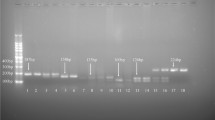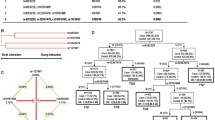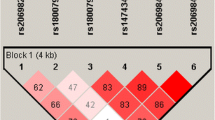Abstract
Purpose
To investigate the association between IL-6 gene polymorphism and cervical cancer risk, and the impact of multiple gene–gene interaction on cervical cancer risk based on a Chinese Han population.
Methods
A total of 1088 women were selected, including 360 cervical cancer patients and 728 control subjects. Logistic regression model was used to examine the association between SNPs within IL-6 and cervical cancer risk. Odds ratio (OR) and 95 % confident interval (95 % CI) were calculated. Generalized multifactor dimensionality reduction (GMDR) was employed to analyze the gene–gene interaction.
Results
Cervical cancer risks were significantly higher in carriers of C allele of rs1800795 polymorphism than those with GG genotype (GC+CC versus GG), adjusted OR (95 % CI) 1.60 (1.24–2.19), and also significantly higher in carriers of G allele of rs2069837 polymorphism than those with AA (AG+GG versus AA), adjusted OR (95 % CI) 1.49 (1.19–2.07). GMDR analysis found a significant gene–gene interaction between rs1800795 and rs2069837 (p = 0.0010). Overall, the two-locus models had a cross-validation consistency of 10 of 10, and had the testing accuracy of 61.72 %. We also calculated the odds ratios and 95 % CI for this interaction, and we found that subjects with GC or CC of rs1800795 and AG or GG of rs2069837 genotype have the highest cervical cancer risk, compared to subjects with GG of rs1800795 and AA of rs2069837 genotype, OR (95 % CI) 3.35 (2.01–4.78).
Conclusions
Minor allele of rs1800795 and rs2069837 and its interaction were associated with increased cervical cancer risk.
Similar content being viewed by others
References
Yang L, Parkin DM, Ferlay J, Li L, Chen Y (2005) Estimates of cancer incidence in China for 2000 and projections for 2005. Cancer Epidemiol Biomarkers Prev 14(1):243–250
Jemal A, Bray F, Center MM, Ferlay J, Ward E, Forman D (2011) Global cancer statistics. CA Cancer J Clin 61(2):69–90
Chang WC, Muo CH, Chang SN, Sung FC, Chang YJ, Kao CH (2013) A nationwide population-based retrospective cohort study: decreased risk of stroke in cervical cancer patients after receiving treatment. Arch Gynecol Obstet 288(4):867–871
Bedoya AM, Jaramillo R, Baena A, Castaño J, Olaya N, Zea AH, Herrero R, Sanchez GI (2013) Location and density of immune cells in precursor lesions and cervical cancer. Cancer Microenviron 6(1):69–77
Barbisan G, Perez LO, Contreras A, Golijow CD (2012) TNF-α and IL-10 promoter polymorphisms, HPV infection, and cervical cancer risk. Tumour Biol 33(6):1549–1556
Yang S, Jia C, Zhu H, Han S (2012) CYP1A1 Ile462Val polymorphism and cervical cancer: evidence from a meta- analysis. Tumour Biol 33:2265–2272
Zhang HL, Zhang YJ (2013) A systemic assessment of the association between tumor necrosis factor alpha 308 G/A polymorphism and risk of cervical cancer. Tumor Biol 34(3):1659–1665
Ishihara K, Hirano T (2002) IL-6 in autoimmune disease and chronic inflammatory proliferative disease. Cytokine Growth Factor Rev 13:357–368
Bowcock AM, Kidd JR, Lathrop GM, Daneshvar L, May LT, Ray A, Sehgal PB, Kidd KK, Cavalli-Sforza LL (1988) The human interferon-beta 2 hepatocyte stimulating factor interleukin-6 gene: DNA polymorphism studies and localization to chromosome 7p21. Genomics 3:8–16
Hamaguchi M, Kawahito Y, Ishino H, Takeuchi N, Tokunaga D, Hojo T, Yamamoto A, Kadoya M, Seno T, Kohno M, Nakada H (2011) Mucin from rheumatoid arthritis synovial fluid enhances interleukin-6 production by human peripheral blood mononuclear cells. Hum Immunol 72(3):241–248
Mosaad YM, Fathy H, Fawzy Z, El-Saied MA (2012) Tumor necrosis factor-α −308 G>A and interleukin-6 −174 G>C promoter polymorphisms and pemphigus. Hum Immunol 73(5):560–565
Tao QS, Huang HL, Chai Y, Luo X, Zhang XL, Jia B, Zhang SQ (2012) Interleukin-6 up-regulates the expression of interleukin-15 is associated with MAPKs and PI3-K signaling pathways in the human keratinocyte cell line, HaCaT. Mol Biol Rep 39(4):4201–4205
Xu B, Niu XB, Wang ZD, Cheng W, Tong N, Mi YY, Min ZC, Tao J, Li PC, Zhang W, Wu HF, Zhang ZD, Wang ZJ, Hua LX, Feng NH, Wang XR (2011) IL-6 −174G>C polymorphism and cancer risk: a meta-analysis involving 29, 377 cases and 37, 739 controls. Mol Biol Rep 38(4):2589–2596
Magalhães JF, Cortinhas AJ, Albuquerque CM, Baptista CS, Ribeiro R, Viegas C, Matos A, Machado J, Pires MA, Guedes-Pinto H, Martins-Bessa A, Leitão JC, Bastos E (2013) Interleukin-6 gene −174G>C and −636G>C promoter polymorphisms and prostate cancer risk. Mol Biol Rep 40(1):449–455
Nogueira de Souza NC, Brenna SM, Campos F, Syrjänen KJ, Baracat EC, Silva ID (2006) Interleukin-6 polymorphisms and the risk of cervical cancer. Int J Gynecol Cancer 16(3):1278–1282
Castro FA, Haimila K, Sareneva I, Schmitt M, Lorenzo J, Kunkel N, Kumar R, Försti A, Kjellberg L, Hallmans G, Lehtinen M, Hemminki K, Pawlita M (2009) Association of HLA-DRB1, interleukin-6 and cyclin D1 polymorphisms with cervical cancer in the Swedish population-a candidate gene approach. Int J Cancer 125(8):1851–1858
Gangwar R, Mittal B, Mittal RD (2009) Association of interleukin-6 −174G>C promoter polymorphism with risk of cervical cancer. Int J Biol Markers 24(1):11–16
Shi TY, Zhu ML, He J, Wang MY, Li QX, Zhou XY, Sun MH, Shao ZM, Yu KD, Cheng X, Wu X, Wei Q (2013) Polymorphisms of the interleukin 6 gene contribute to cervical cancer susceptibility in eastern Chinese women. Hum Genet 132(3):301–312
Shepherd JH (1995) FIGO staging of gynecologic cancers; cervical and vulva. Int J Gynecol Cancer 5:319
Hammes LS, Tekmal RR, Naud P, Edelweiss MI, Kirma N, Valente PT, Syrjanen KJ, Cunha-Filho JS (2007) Macrophages, inflammation and risk of cervical intraepithelial neoplasia (CIN) progression- clinic- pathological correlation. Gynecol Oncol 105:157–165
Grimm C, Watrowski R, Baumühlner K, Natter C, Tong D, Wolf A, Zeillinger R, Leodolter S, Reinthaller A, Hefler L (2011) Genetic variations of interleukin-1 and -6 genes and risk of cervical intraepithelial neoplasia. Gynecol Oncol 121(3):537–541
Shi WJ, Liu H, Wu D, Tang ZH, Shen YC, Guo L (2014) Stratification analysis and case-control study of relationships between Interleukin-6 gene polymorphisms and cervical cancer risk in a chinese population. Asian Pac J Cancer Prev 15(17):7357–7362
Fishman D, Faulds G, Jeffery R, Mohamed-Ali V, Yudkin JS, Humphries S, Woo P (1998) The effect of novel polymorphisms in the interleukin-6 (IL-6) gene on IL-6 transcription and plasma IL-6 levels, and an association with systemic-onset juvenile chronic arthritis. J Clin Invest 102:1369–1376
Acknowledgments
The writing of this paper was supported by Shanghai First Maternity, Infant Hospital and Shanghai First Maternity and Infant Hospital and Shanghai Key Laboratory of Gynecologic Oncology. We thank all the partners and staffs who help us in the process of this study. Xiaowen Pu and Zhuowei Gu contributed equally to this work.
Author information
Authors and Affiliations
Corresponding author
Ethics declarations
Conflict of interest
All authors declare that they have no conflict of interest.
Ethical approval
All procedures performed in studies involving human participants were in accordance with the ethical standards of the institutional and/or national research committee and with the 1964 Helsinki Declaration and its later amendments or comparable ethical standards.
Informed consent
Informed consent was obtained from all individual participants included in the study.
Additional information
X. Pu and Z. Gu contributed equally to this work.
Rights and permissions
About this article
Cite this article
Pu, X., Gu, Z. & Wang, X. Polymorphisms of the interleukin 6 gene and additional gene–gene interaction contribute to cervical cancer susceptibility in Eastern Chinese women. Arch Gynecol Obstet 294, 1305–1310 (2016). https://doi.org/10.1007/s00404-016-4175-x
Received:
Accepted:
Published:
Issue Date:
DOI: https://doi.org/10.1007/s00404-016-4175-x




